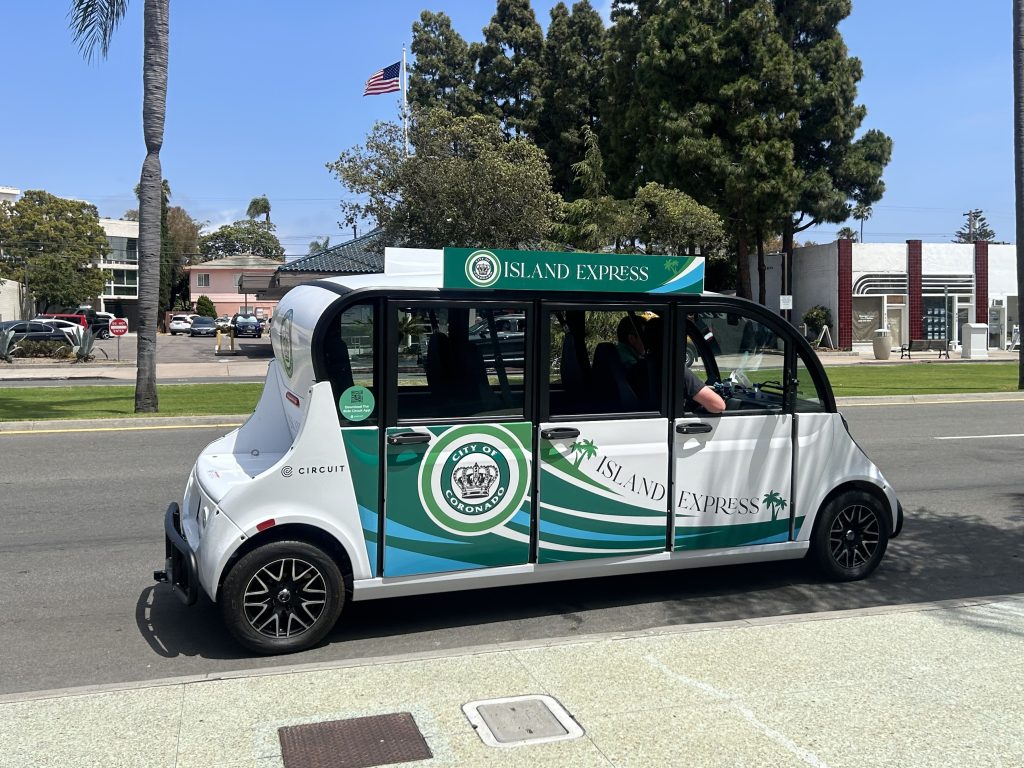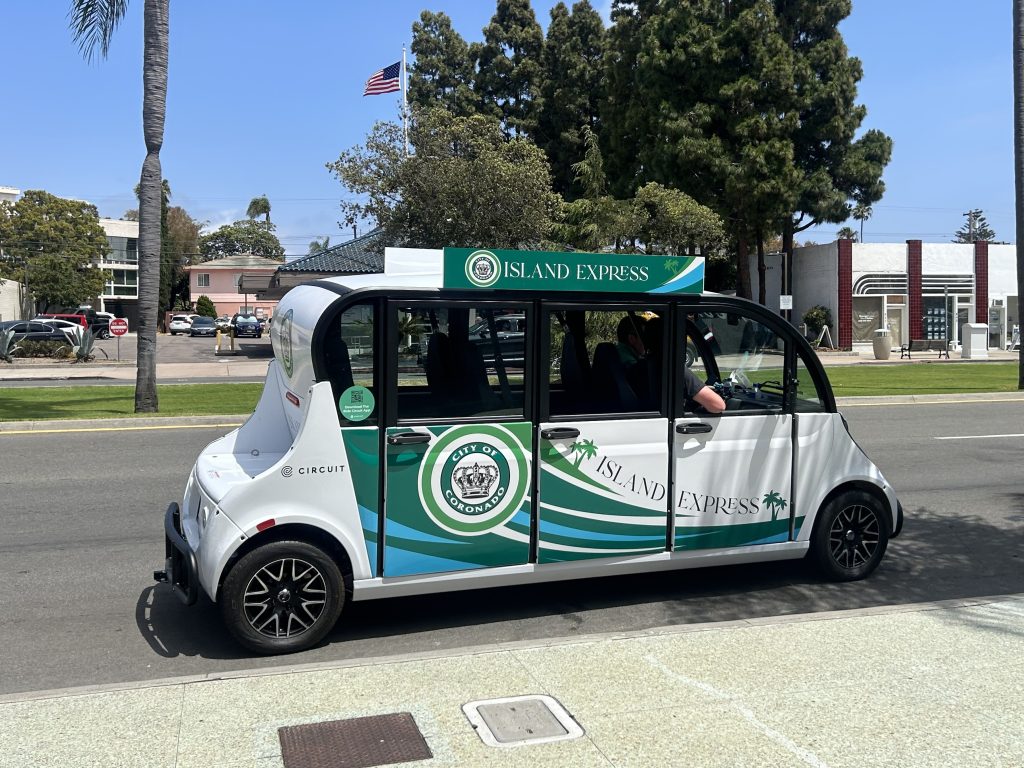 Circuit Island Express electric shuttle on Orange Avenue on June 3, 2024. (Photo by Dani Schwartz.)
Circuit Island Express electric shuttle on Orange Avenue on June 3, 2024. (Photo by Dani Schwartz.)
Coronado’s Island Express program was a hit with riders, and a hit to the city’s budget.
The city is exploring cost-saving measures that could support a permanent return of the mini shuttle service. These could include ride fares, advertising on the vehicles, cost-sharing with hotels, or grant funding, though nothing is decided yet.
The Coronado City Council on Oct. 21 authorized city staff to release a request for proposals (RFP) for the project so the city can see what its options and their associated costs are.
A six-month pilot of the Island Express in 2024 cost the city $561,509. During that time, the shuttle completed an average of 163 rides per day for 58,596 passengers. Most of the riders — 89 percent of them — were in the Village.
The shuttle was free to ride during the pilot, a choice that was never meant to be permanent. Rather, the city hoped to gauge interest in a shuttle service by offering it for free temporarily.
The pilot was run by Circuit, a microtransit company that also operates San Diego’s FRED shuttle. The City Council in March decided to explore ways to reduce costs for restoring the shuttle, including releasing an RFP.
City Manager Tina Friend said she expects that the RFP would be ready in early 2026.
Although no decisions were made at the recent meeting, the council gave feedback on how a permanent program could look. Among the biggest questions still facing the program is whether — and how — to include the Coronado Cays, which proved the most expensive area to serve during the pilot.
Councilmembers supported a fee for riding ($5 per ride was suggested). Pilot passengers indicated via a survey that they would be willing to pay a small fee for the service, and Councilmember Amy Steward said she witnessed people tipping their drivers with $20 bills.
The council was amenable to exploring cost-sharing with local hotels. Hotels were among the top pick-up and drop-off locations during the shuttle’s pilot. Another option would be to use a geofence to exclude hotels from the program, but Mayor John Duncan objected, saying the goal is fewer cars on the road, regardless of who is driving them.
However, Duncan said he would support charging visitors more for rides, another option to curb costs. Councilmember Mark Fleming disagreed, saying that visitors bring revenue to and value to the city.
The pilot included a call center, which cost $62 per call and yielded 223 rides. The council agreed to eliminate that in a permanent shuttle program, although Councilmember Carrie Downey suggested exploring an alternative to only booking rides on an app to improve accessibility.
The council was amenable to allowing children to ride the shuttle, although there was no consensus on the parameters. Council Member Amy Steward said younger elementary school students should not be able to ride solo, while Downey favored leaving it to parental discretion.
The council also favored an all-electric fleet. A catalyst for the program was to reduce the city’s carbon footprint and reduce cars on city streets per Coronado’s Climate Action Plan. The city estimates that during the pilot program, the electric shuttles offset 7.8 metric tons of greenhouse gas emissions. (A 10-kilowatt residential, rooftop solar system would reduce about 4 metric tons in the same time period.)
The council seemed to favor a year-round service, with Councilmember Mark Fleming noting that suspending it during slower, winter months might confuse people about when and if the service were available.
The question of the Cays
Noting that it may be difficult financially, the council also asked that staff explore options for including the Coronado Cays in some manner.
Unsurprisingly, service to the Coronado Cays was the most expensive part of the Island Express pilot program. The mini shuttles cannot legally drive on State Route 75 to the Cays, so Circuit used vans. Rides to the Cays constituted 11 percent of total rides, and cost an average of $29 per passenger, compared to the $7 per passenger in the Coronado Village.
One potential way to cut costs for service to the Cays would be to use a routed system for the Cays, rather than allowing on-demand, door-to-door service. Councilmember Kelly Purvis suggested scheduling regular pick-ups between a location in the Cays and in the Village, rather than an on-demand service.
None of this is set in stone; the council was simply providing direction for city staff as it prepares its RFP. Overall, the council’s goal is to restore the shuttle program while balancing it with budgetary concerns.
“My whole philosophy on it is simple,” Duncan said. “I want the staff to tell us how to make it work. That’s it. We can tell them what our parameters are, but if we need to face the financial realization that it’s impossible to do certain parts of the service, then that’s the reality.”

